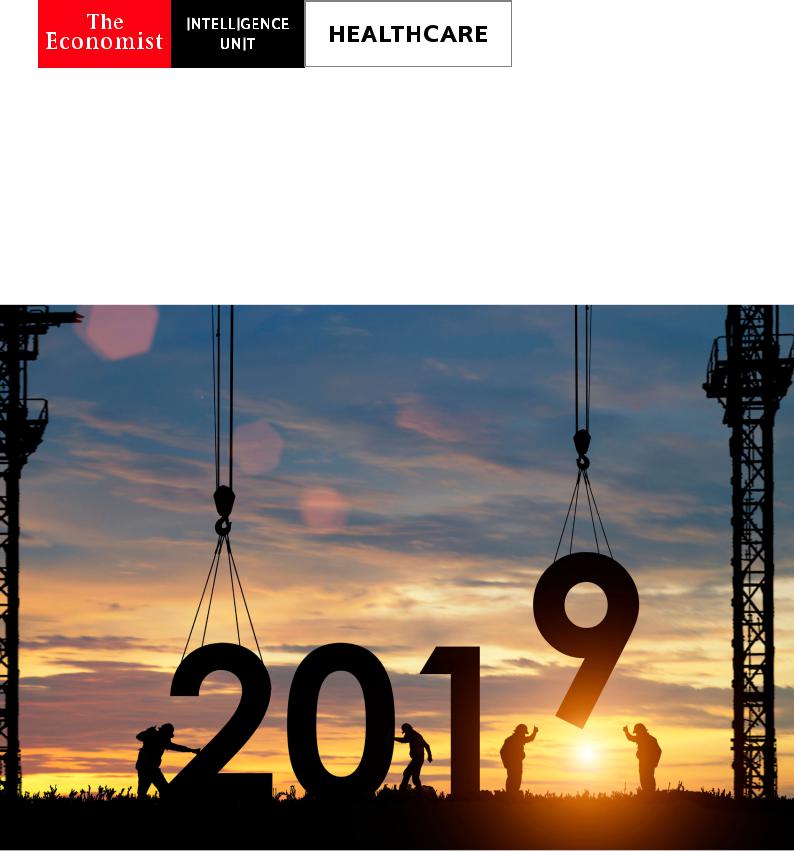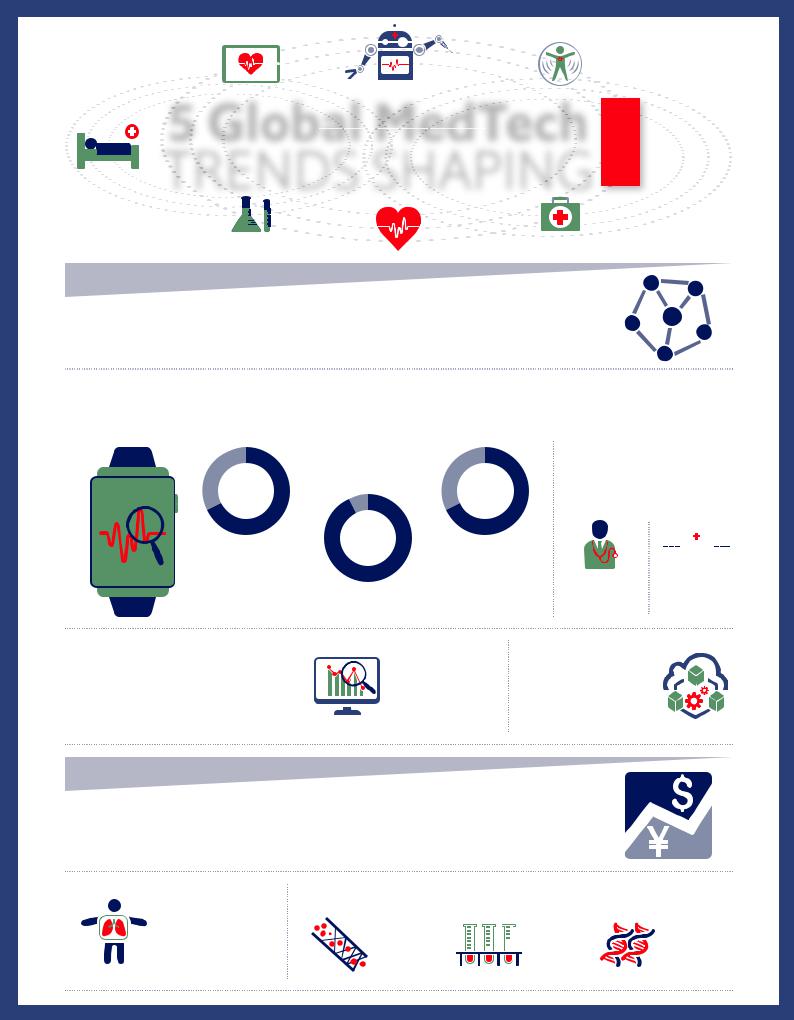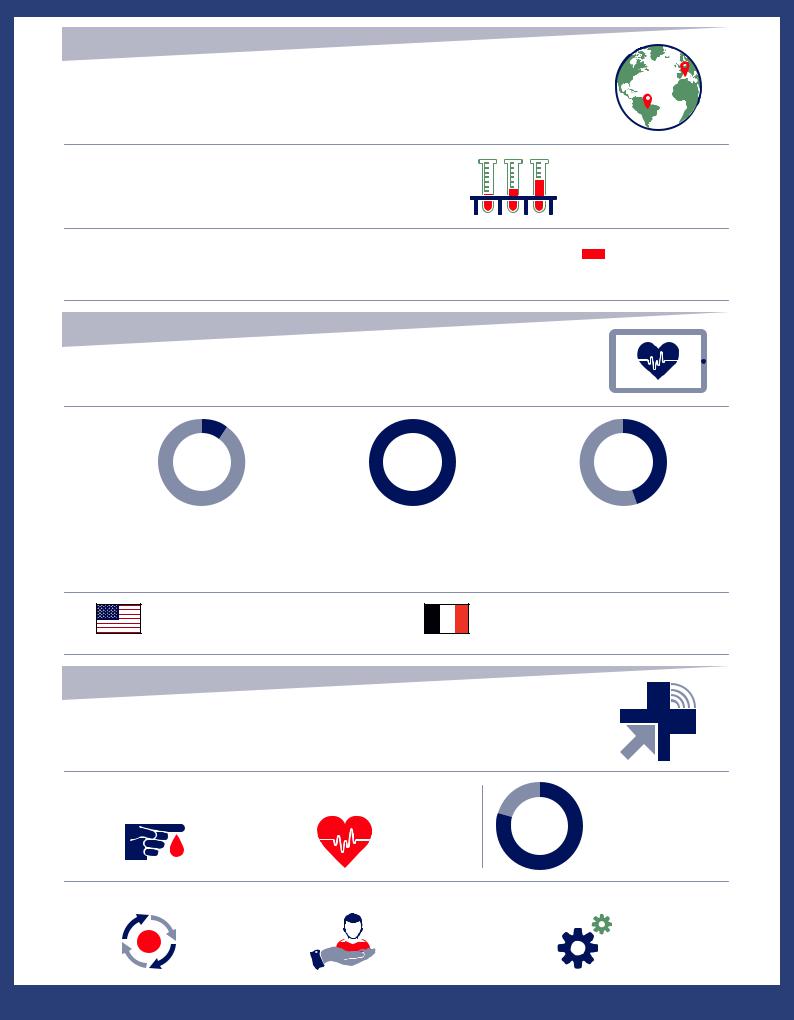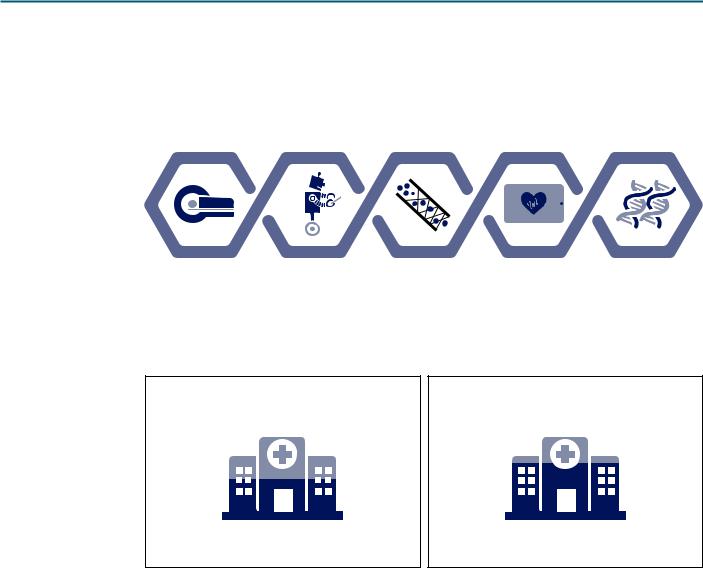
The Economist IU - MedTech in Emerging_Markets - 2019_watermark
.pdf
РЕЛИЗ ПОДГОТОВИЛА ГРУППА "What's News" VK.COM/WSNWS
vk.com/id446425943
MedTech in Emerging Markets 2019
A market access trend report in emerging markets
A report by The Economist Intelligence Unit

РЕЛИЗ ПОДГОТОВИЛА ГРУППА "What's News" VK.COM/WSNWS
vk.com/id446425943
The world leader in global business intelligence
The Economist Intelligence Unit (The EIU) is the research and analysis division of The Economist Group, the sister company to The Economist newspaper. Created in 1946, we have over 70 years’ experience in helping businesses, financial firms and
governments to understand how the world is changing and how that creates opportunities to be seized and risks to be managed.
Given that many of the issues facing the world have an international (if not global) dimension, The EIU is ideally positioned to be commentator, interpreter and forecaster on the phenomenon of globalisation as it gathers pace and impact.
EIU subscription services
The world’s leading organisations rely on our subscription services for data, analysis and forecasts to keep them informed about what is happening around the world. We specialise in:
•Country Analysis: Access to regular, detailed country-specific economic and political forecasts, as well as assessments of the business and regulatory environments in different markets.
•Risk Analysis: Our risk services identify actual and potential threats around the world and help our clients understand the implications for their organisations.
•Industry Analysis: Five year forecasts, analysis of key themes and news analysis for six key industries in 60 major economies. These forecasts are based on the latest data and in-depth analysis of industry trends.
EIU Consulting
EIU Consulting is a bespoke service designed to provide solutions specific to our customers’ needs. We specialise in these key sectors:
•EIU Consumer: We help consumer-facing companies to enter new markets as well as deliver greater success in current markets. We work globally, supporting senior management with strategic initiatives, M&A due diligence, demand forecasting and other issues of fundamental importance to their corporations. Find out more at eiu.com/consumer
•Healthcare: Together with our two specialised consultancies, Bazian and Clearstate, The EIU helps healthcare organisations build and maintain successful and sustainable businesses across the healthcare ecosystem. Find out more at: eiu.com/ healthcare
•Public Policy: Trusted by the sector’s most influential stakeholders, our global public policy practice provides evidencebased research for policy-makers and stakeholders seeking clear and measurable outcomes. Find out more at: eiu.com/ publicpolicy
The Economist Corporate Network
The Economist Corporate Network (ECN) is The Economist Group’s advisory service for organisational leaders seeking to better understand the economic and business environments of global markets. Delivering independent, thought-provoking content, ECN provides clients with the knowledge, insight, and interaction that support better-informed strategies and decisions.
The Network is part of The Economist Intelligence Unit and is led by experts with in-depth understanding of the geographies and markets they oversee. The Network’s membership-based operations cover Asia-Pacific, the Middle East, and Africa. Through a distinctive blend of interactive conferences, specially designed events, C-suite discussions, member briefings, and high-calibre research, The Economist Corporate Network delivers a range of macro (global, regional, national, and territorial) as well as industry-focused analysis on prevailing conditions and forecast trends.

РЕЛИЗ ПОДГОТОВИЛА ГРУППА "What's News" VK.COM/WSNWS
vk.com/id446425943
MEDTECH IN EMERGING MARKETS 2019
A MARKET ACCESS TREND REPORT IN EMERGING MARKETS
Contents
Foreword |
2 |
Infographic: Global medtech trends shaping 2019 |
3 |
The rise of emerging market medtech companies |
5 |
Paying for medtech innovation in emerging markets |
8 |
Diagnostic innovation and private health insurance: Rethinking their alignment |
10 |
Are emerging market hospitals ready for health innovation? |
13 |
Growing your medtech business in emerging markets |
16 |
About the authors |
17 |
1 |
© The Economist Intelligence Unit Limited 2019 |

РЕЛИЗ ПОДГОТОВИЛА ГРУППА "What's News" VK.COM/WSNWS
vk.com/id446425943
MEDTECH IN EMERGING MARKETS 2019
A MARKET ACCESS TREND REPORT IN EMERGING MARKETS
Foreword
As we begin 2019, the Economist Intelligence Unit (EIU) Healthcare highlights key trends in the global medical technology (medtech) industry in 2019 – from the industry coming under
pressure as US-China economic and technological rivalry continues to unfold to the pick-up of remote monitoring and telehealth solutions.
The report focusses on the implications of some of these trends on emerging markets as companies look to gain greater access to these fast-growing high-potential markets. We look at various opportunities and challenges to help companies understand where and how emerging market medtech companies are evolving as even stronger competitors in 2019, and affordability and infrastructure issues in these markets.
2019 will also mark significant milestones for EIU Healthcare after our acquisition of data information intelligence GmbH (dii), a leading healthcare consultancy and market research provider with a focus on the diagnostic, medical devices and imaging market in 2018 and the launch of our redeveloped data product, Surgical Gateway. In 2019, dii’s expertise in sizing the in-vitro diagnostics (IVD) market in European countries will complement the growing strengths of our IVD Gateway database, which will relaunch on a new interface to continue to deliver precise data and forecasts for each of the major IVD segments in Asia-Pacific and Latin America. Surgical Gateway employs data science and analytics techniques to integrate macro insights – from our primary research data on surgical endusers, population health data, patient affordability, hospital capacity to derive market size, share and growth data, to build accurate estimates and forecasts of surgical device and consumables demand across 27 countries worldwide.
We look ahead to the opportunities for medtech companies, governments, payers and various partners to work together to improve access to medtech in emerging markets.
Jin Li Frick
Head, MedTech & Life Sciences Consulting
EIU Healthcare
2 |
© The Economist Intelligence Unit Limited 2019 |

РЕЛИЗ ПОДГОТОВИЛА ГРУППА "What's News" VK.COM/WSNWS
vk.com/id446425943
Global MedTech
TRENDS SHAPING
 2019
2019
1Data-driven healthcare approaches among consumers and healthcare providers demand for greater connectivity.
Consumers are increasingly expecting medtech to connect over a single platform to o er a holistic solution to multiple needs and demands. High net worth individuals (HNWIs) in Asia, Middle East and Africa polled by the EIU believe that the collection of personal health data will improve their ability to care for their health.
|
|
|
|
Top two barriers to greater adoption |
||||
|
|
|
|
of a personal data-driven approach |
||||
|
75% |
|
|
to healthcare according to HNWIs in |
||||
|
|
|
Asia, Middle East and Africa |
|||||
|
Think monitoring their |
93% |
Use wearable health |
|
|
|
|
|
|
|
|
|
|
|
|||
|
|
|
|
|
|
|||
|
|
|
|
|
|
|||
|
health gives them a greater |
|
devices for multiple |
|
|
|
|
|
|
feeling of control over it |
Use wearable |
purposes |
Lack of trained |
Gaps in local |
|||
|
|
|
||||||
|
|
|
healthcare |
healthcare |
||||
|
|
health devices |
|
professionals |
infrastructure |
|||
Medtech needs to connect over a single platform for healthcare providers pursuing data-driven healthcarethat will need broad sets of data to come together in a connected ecosystem.
76% |
Interoperability |
Healthcare organisations |
is one of the top three areas of |
planning to invest heavily |
focus for 2019 for US healthcare |
in big data and analytics |
providers. |
2Medtech comes under pressure as US-China economic and technological rivalry continues to unfold in 2019.
>US$1.1bn
Estimated total annual value of medical imaging products subjected to US and China tari s implemented in 2018
Fast-growing and high value medtech segments to watch for intensifying competition and potential trade risks:
High-value |
|
|
|
|
|
In-vitro |
Gene |
||
|
|
|
|||||||
medical |
|
|
|
|
|
|
diagnostics |
sequencing |
|
|
|||||||||
|
|
|
|
|
|
||||
consumables |
|
|
|
|
|
(IVD) |
|
||

РЕЛИЗ ПОДГОТОВИЛА ГРУППА "What's News" VK.COM/WSNWS
vk.com/id4464259433
Emerging market medtech companies are bolstering their competitiveness in global markets through product innovation and successful go-to-market strategies.
Emerging market medtech companies |
4 |
|
10 |
|
out of |
||||
|
||||
are cementing their presence in their |
of the biggest |
|||
IVD players in China |
||||
domestic market. |
||||
are domestic companies. |
||||
|
||||
Emerging market medtech companies are increasingly capturing a larger share of overseas markets – in midand higher-end medtech product segments.
In China’s IVD market, the fastest-growing companies across all four major IVD market segments are domestic ones.
2 out of 3
hospitals in the US use medical equipment from Mindray – China’s largest medtech company
4Wider adoption of remote monitoring and telehealth under favourable reimbursement schemes.
10% |
100% |
45% |
US healthcare providers polled report that |
All US healthcare providers polled anticipate |
With reimbursement increasing, 45% of US |
less than 10% of their total care delivery is |
use of telehealth to grow over the next |
healthcare providers polled expect a significant |
provided through telehealth. |
three years. |
increase - more than 10% increase, in the share of |
|
|
total care delivery that will be provided through |
|
|
telehealth, over the next 3 years. |
Three new remote patient monitoring reimbursement medical codes introduced in the US 2019 Physician Fee Schedule and Quality Payment Program
New reimbursement policies in France that kicked in September 2018 allows for telehealth services to be reimbursed at the same rate as non-telehealth services.
5Big Tech is becoming a more direct competitor in medtech.
In 2018, Amazon launched its own medical device brand focused on diabetes and cardiovascular devices that work with Apple Health and Amazon’s Alexa.
Diabetes |
Cardiovascular |
80% |
medical devices |
medical devices |
|
Healthcare providers see potential for collaboration with Big Tech in:
Streamlining |
Implementing |
provider |
consumer-focused |
workflows |
services |
of healthcare providers polled are paying close attention to Big Tech’s entry into the healthcare space, recognising the opportunities to redesign their care models by working with these companies.
Solving supply chain challenges
Sources: Economist Intelligence Unit, Company websites (Amazon, Mindray), ‘Top of Mind for Top Health Systems 2019’, Center for Connected Medicine.

РЕЛИЗ ПОДГОТОВИЛА ГРУППА "What's News" VK.COM/WSNWS
vk.com/id446425943
MEDTECH IN EMERGING MARKETS 2019
A MARKET ACCESS TREND REPORT IN EMERGING MARKETS
The rise of emerging market medtech companies
Medtech industry executives are wondering exactly how fast domestic companies have grown in their domestic markets; and more importantly: how sustainable is their growth. US medtech
companies have been the largest supplier of medtech to emerging countries such as China, India and Brazil for the past decade or so. But the dominance of medtech multinationals (MNCs) in emerging markets are increasingly being challenged by emerging market medtech companies that are becoming stronger competitors not just in their domestic market, but also in other emerging markets who
share similar infrastructure and affordability challenges when it comes to using medical devices and equipment. In 2019, the presence of emerging market medtech companies will continue to strengthen in emerging markets.
China and India set their sights on a bigger share of the medtech market – in midand high-end device segments
Many of India’s domestic medtech companies – some 800 of them, produce low-value consumables and disposables that dominate the local market, while the country continues to import most of its specialised medical devices and equipment.
The trend of relying on foreign medtech companies could reverse as more Indian companies are increasingly finding their niche in midand higher-end medtech product segments. Blueneem, a ten-year-old Indian company, now exports more than half of the medical devices – from stents to diagnostic devices it develops and manufactures.
In China, domestic medtech companies have already found their footing in some the fastestgrowing, most lucrative medtech market segments. Imaging, in-vitro diagnostics (IVD) and high-value medical consumables are some of the largest and fastest-growing markets in China where Chinese companies have also emerged as strong competitors in recent years and are hot on the heels of medtech MNCs. According to analysis by the EIU Healthcare, four out of the ten companies with the biggest share of China’s IVD market are domestic companies. Locally, domestic companies beat out growth rates of MNCs by a large margin – the fast-growing companies in main IVD market segments such as molecular diagnostics and point-of-care testing are all domestic players.1 Mindray – China’s largest medtech company has captured almost half of Chinese high-end patient monitoring market.2 There is still room for further growth in the domestic market. Under the Made in China 2025 plan, China wants domestically produced medical devices to take up 50% of midand high-end medical devices used by its hospitals by 2020 – and to further increase to 70% by 2025.
1.EIU Healthcare (IVD Gateway)
2.National Business Daily, 2018
5 |
© The Economist Intelligence Unit Limited 2019 |

РЕЛИЗ ПОДГОТОВИЛА ГРУППА "What's News" VK.COM/WSNWS
vk.com/id446425943
MEDTECH IN EMERGING MARKETS 2019
A MARKET ACCESS TREND REPORT IN EMERGING MARKETS
Figure 1: Made in China 2025 – Medtech focus areas |
|
|
|
Imaging |
High-value |
|
Gene |
medical consumables |
|
||
equipment |
(e.g. degradable vascular stents) |
|
sequencing |
|
|
|
|
|
|
|
|
Medical |
Remote diagnosis |
robots |
and treatment devices |
Source: State Council (China).
Figure 2: Made in China 2025 – More domestic medical devices will be used at
Chinese hospitals
By 2020, |
50% |
By 2025, |
70% |
||
|
|
||||
|
|
|
|
|
|
Of midand high-end medical devices used at Chinese hospitals will be domestic devices
Of midand high-end medical devices used at Chinese hospitals will be domestic devices
Source: Ministry of Industry and Information Technology
Chinese medtech companies are increasingly winning over a larger share of not just their domestic market but overseas markets, and in higher-value segments – quickly catching up to the US. Imports of each other’s medtech for the two countries are almost on par in 2017 – with the US importing slightly more of medtech (by about 6%) from China based on the value, than the latter does from it.
Medtech for emerging markets, by emerging markets
Companies with emerging market expansion plans should be prepared to face fiercer competition from emerging market players. Cost can be a factor in choosing medtech products manufactured in emerging markets – the lower-end range of prosthetic limbs from the West cost up to 40 times more than those made in a developing country. However, increasingly, the development of devices and related initiatives that make it feasible and easy to use in emerging markets are driving these choices.
Companies need a strong underlying understanding of local infrastructure, healthcare systems and users to develop the right type of technology. Limited infrastructure and lack of skilled healthcare professionals in emerging markets make the use of standard medical devices challenging. In Peru, rural and poor populations reside in distinct geographic regions, each with its own unique challenges.
6 |
© The Economist Intelligence Unit Limited 2019 |

РЕЛИЗ ПОДГОТОВИЛА ГРУППА "What's News" VK.COM/WSNWS
vk.com/id446425943
MEDTECH IN EMERGING MARKETS 2019
A MARKET ACCESS TREND REPORT IN EMERGING MARKETS
Limited road networks connect populations living in Peru’s Andes highlands to equipment and resources concentrated in city hospitals; while infectious diseases such as malaria, dengue – that physicians face challenges telling apart with the lack of diagnostic tests on hand – are a problem for those living in the tropical Amazon basin. Point-of-care devices and ultrasound equipment are some of the medical equipment physicians working at primary health facilities in rural Peru highlight to be lacking in their facility. Physicians would also like to see equipment adapted for use in rural settings – such as ultrasound devices of a convenient size to carry to isolated villages or for home consultations.3
One rural healthcare programme in China attempts to solve the challenges faced by physicians in low-resource settings. Working with the government, WeDoctor – a Tencent-backed online healthcare platform, brought portable all-in-one diagnostic devices designed by the company to more than 300 villages in rural areas of China’s Henan province and trained up village physicians on using the device. The device can run 11 tests from measuring blood pressure to routine urine and blood analysis, and automatically uploads medical records after generating its diagnosis that will be reviewed by physicians at city hospitals.
Even as rural health initiatives grow with data connectivity and technology, infrastructural gaps and the lack of healthcare professionals will continue to be challenges in emerging markets. There is a need for the right medtech to support care carried out in rural facilities as they pick up on local demand for healthcare.
3.‘Diagnostic barriers and innovations in rural areas: insights from junior medical doctors on the frontlines of rural care in Peru’,
BMC Health Services Research, 2015
7 |
© The Economist Intelligence Unit Limited 2019 |

РЕЛИЗ ПОДГОТОВИЛА ГРУППА "What's News" VK.COM/WSNWS
vk.com/id446425943
MEDTECH IN EMERGING MARKETS 2019
A MARKET ACCESS TREND REPORT IN EMERGING MARKETS
Paying for medtech innovation in emerging markets
Emerging markets continue to face affordability related challenges in accessing quality healthcare, especially when it comes to accessing more advanced medical technology. More innovative
medical technology are primarily accessed through the private market to those who can afford to pay out of pocket. Patients have a tendency to prioritise out-of-pocket spending on therapy rather than diagnosis – where much of medical technology go towards supporting, hence picking fewer, less complex and lower quality medical tests even when potentially more effective options are available. When reimbursement is provided by public or private schemes, the tendency is converse.4 We look at the potential of government and third-party payers to improve access to medical technology.
4.‘An Essential Pathology Package for Low-
and Middle-Income Countries’, American Journal of Clinical Pathology, 2017
5.WHO, 2017
6.Health Policy Plus, 2018
7.Ibid.
8.EIU (Note: Highincome consumers refer to individuals with a grey income-adjusted disposable income of above Rmb200,000 per year)
9.China Daily, 2018
Can governments spend more on medtech?
Universal health coverage and other government funded access schemes remain the most promising means for bridging access gaps in middle-income countries. On the World Health Organisation’s (WHO) calculation, most middle-income countries will have the capacity to self-finance universal health coverage for their population, providing access to what WHO views as essential and affordable medical technology.5 The world’s most populous middle-income countries – China, India, Indonesia are strengthening coverage through various schemes. Indonesia targets to have its entire population covered under Jaminan Kesehatan Nasional (JKN) in 2019 – its national health insurance programme first introduced in 2014. 75% of private hospitals contracted under JKN have increased their investment in medical equipment since JKN started, particularly in areas of new medtech such as GeneXpert machines that shortens the time take to diagnose tuberculosis from several weeks to a few hours.6
However, universal health coverage can be shallow. Patient access to more recent medical technology which may be more cost-effective, but more expensive to implement is also lacking. Although prices of genetic sequencing tests have fallen over time, they are relatively expensive tests and hence an unlikely candidate for inclusion into already stretched public healthcare insurance schemes. Limited equipment and materials, underdeveloped laboratory services and expertise, and large rural populations also brings up the cost of the implementation of such newer technologies
in emerging markets. It is estimated that getting lowand middle-income countries – which make up roughly 75% of the world’s population, to provide universal health coverage by 2030 will cost US$274– US$371bn annually. Infrastructure – the building and operating of new clinics, hospitals and laboratories, including buying medical equipment makes up about 34% of the cost.7
Smaller scale government reimbursement schemes are plugging the gaps in patient access to more advanced medtech. In China, genetic sequencing tests for non-invasive (NIPT) and cancer screening are not covered by public health insurance at the national level. Shenzhen – a Chinese city with the third largest number of high-income consumers,8 has started providing coverage for NIPT in 2017. An NIPT service costs about Rmb2,500 (US$364) - 10 times more than a conventional blood test.9 It is anticipated that Yunnan will be the next province to start reimbursing NIPT services.
8 |
© The Economist Intelligence Unit Limited 2019 |
